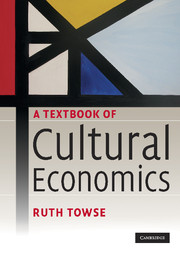Book contents
- Frontmatter
- Contents
- List of figures
- List of tables
- List of boxes
- List of abbreviations
- Preface
- Part I General issues in cultural economics
- Part II The ‘traditional’ economics of the arts and heritage
- Part III Artists' labour markets and copyright
- Part IV The creative industries
- Introduction
- 14 Economics of creative industries
- 15 Economics of the music industry
- 16 Economics of the film industry
- 17 Economics of broadcasting
- 18 Economics of book publishing
- 19 Economics of festivals, creative cities and cultural tourism
- Part V Conclusion and exercises and problems
- References
- Index
15 - Economics of the music industry
- Frontmatter
- Contents
- List of figures
- List of tables
- List of boxes
- List of abbreviations
- Preface
- Part I General issues in cultural economics
- Part II The ‘traditional’ economics of the arts and heritage
- Part III Artists' labour markets and copyright
- Part IV The creative industries
- Introduction
- 14 Economics of creative industries
- 15 Economics of the music industry
- 16 Economics of the film industry
- 17 Economics of broadcasting
- 18 Economics of book publishing
- 19 Economics of festivals, creative cities and cultural tourism
- Part V Conclusion and exercises and problems
- References
- Index
Summary
This chapter concentrates mainly on music publishing and sound recording, as I have elsewhere touched on many of the other segments of the music industry: composers and performers were included in the analysis of artists' labour markets in chapters 11 and 12 and the role of copyright in chapter 13; chapter 8 discussed music, dance and opera as performing arts. The topics of the general introduction to the creative industries in chapter 14 all apply to the music industry and are investigated in further detail here.
Technical change and copyright
Music was one of the first of the cultural industries to be afforded protection through copyright law: as early as the nineteenth century composers were protected by authors' rights under the Berne Convention, and in the early years of the twentieth century music publishers and composers were granted so-called ‘mechanical rights’ in the mechanical reproduction of music, initially using piano rolls and, later, sound recording, and composers' so-called ‘synchronisation’ rights enable them also to control the use of their music on TV and in film and video. With the spread of radio ownership, the public performance of music led to copyright legislation that enabled composers and publishers to collect remuneration for the public performance of music from broadcasting, and this right was later extended to sound recording makers and performers. Other public performance of music also requires a licence, which is issued by a collecting society (see chapter 13).
- Type
- Chapter
- Information
- A Textbook of Cultural Economics , pp. 405 - 433Publisher: Cambridge University PressPrint publication year: 2010



